Abstract
AIM: To compare the growth of very low birthweight (VLBW) children in early adolescence with that of their normal birthweight peers; to examine the role of factors contributing to growth-parental height, perinatal variables, bone maturity and sexual maturation; to examine the correlation between head growth and cognitive and educational outcome. METHODS: Standing and sitting heights, weight, occipito-frontal circumference (OFC), skinfold thicknesses and pubertal staging were assessed in 137 VLBW children and 160 controls at 11-13.5 years of age. Ninety six (70%) of the VLBW children had their bone age assessed using the TW2 method. Reported parental heights were obtained by questionnaire. All children had standardised tests of cognitive and educational ability. Perinatal data had been collected prospectively as part of a longitudinal study. RESULTS: VLBW children had lower heights, weight, and OFC. Skinfold thicknesses were no different. The children's short stature was not accounted for by difference in parental height, degree of pubertal development, or by retarded bone age. Indeed, the TW2 RUS score was significantly advanced in the VLBW children. Using the bone ages to predict final adult height, 17% have a predicted height below the third centile and 33% below the tenth. Weight was appropriate for height, but there was a residual deficiency in OFC measurements after taking height into account. In the VLBW group smaller head size was associated with lower IQ and mathematics and reading scores. CONCLUSIONS: Growth problems persist in VLBW children and final heights may be even more abnormal than present heights suggest. VLBW children have smaller OFCs than expected from their short stature alone and this may be associated with poorer educational and cognitive outcomes.
Full text
PDF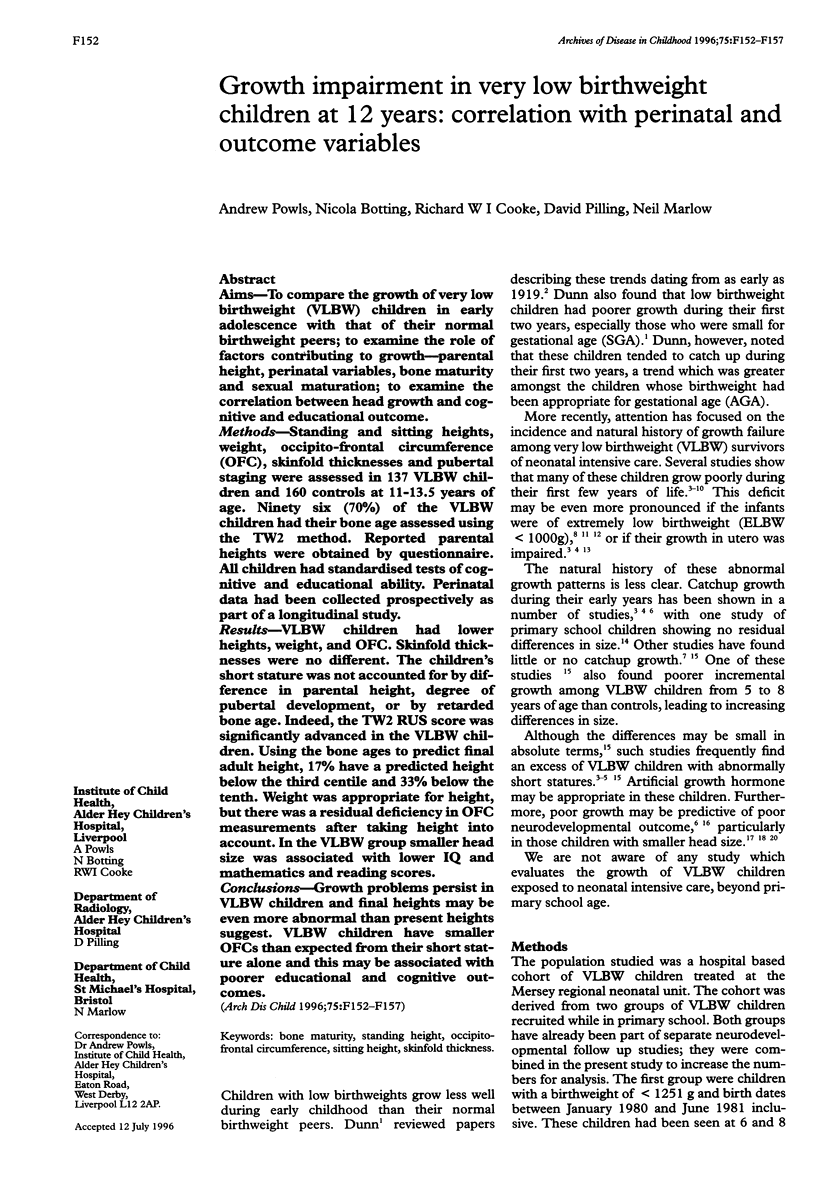
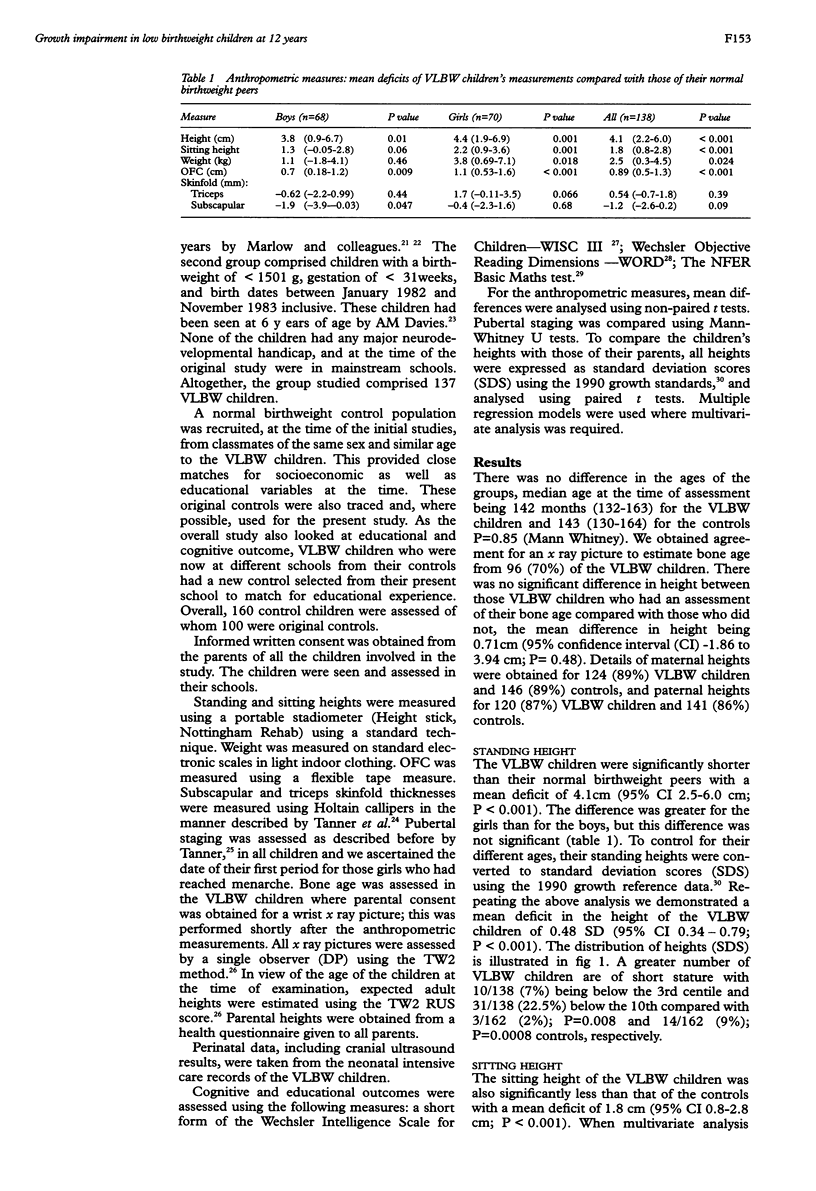
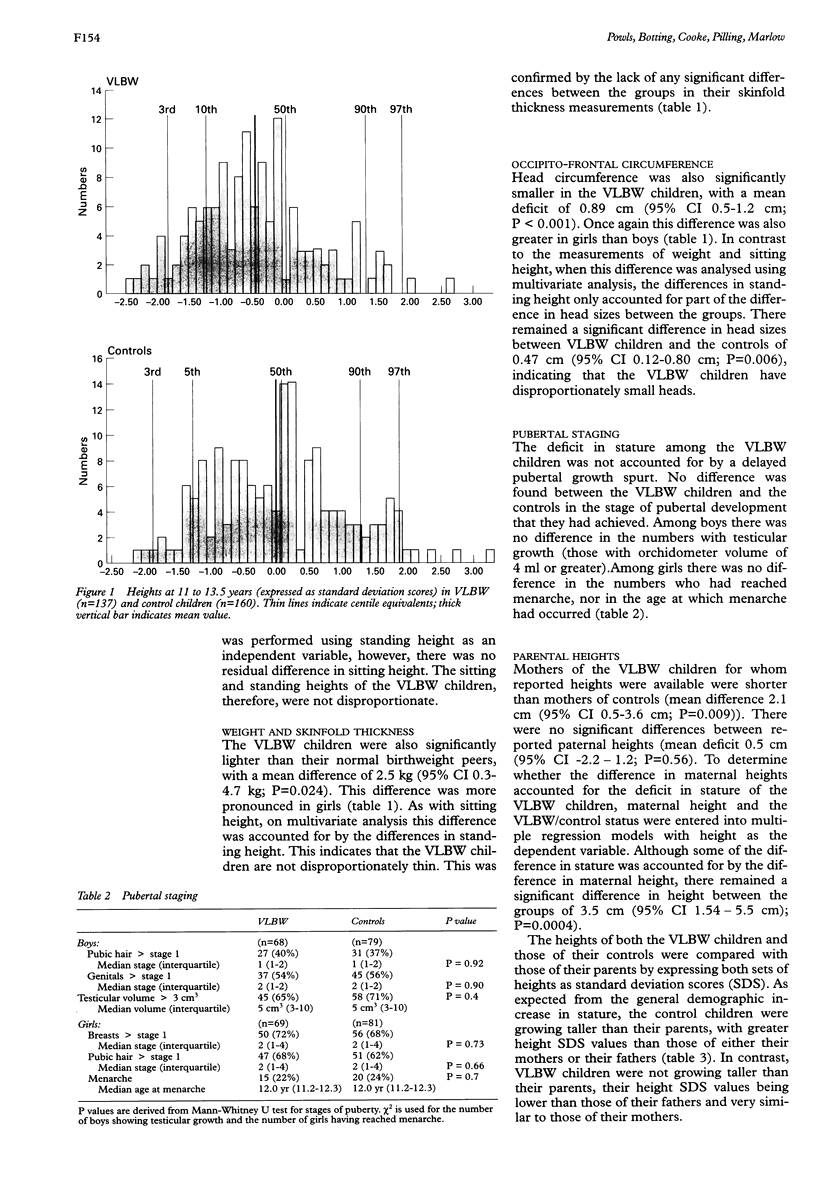
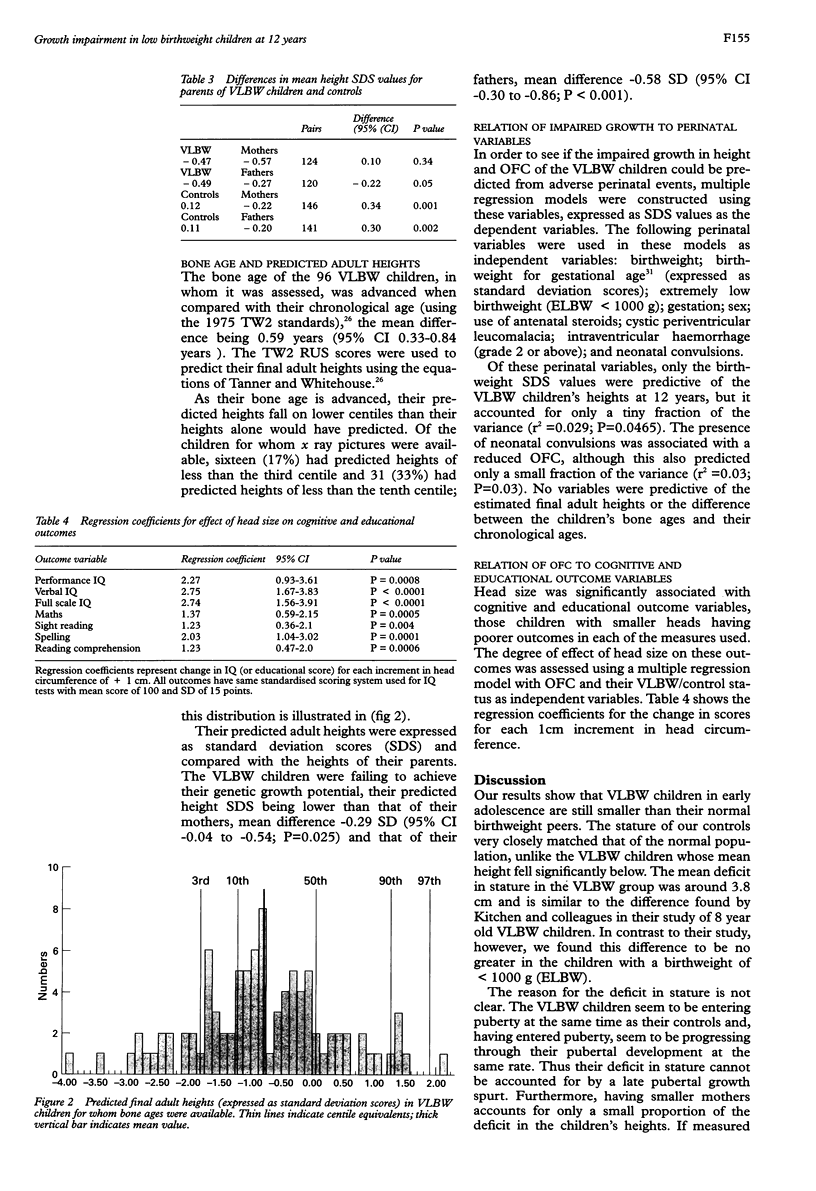
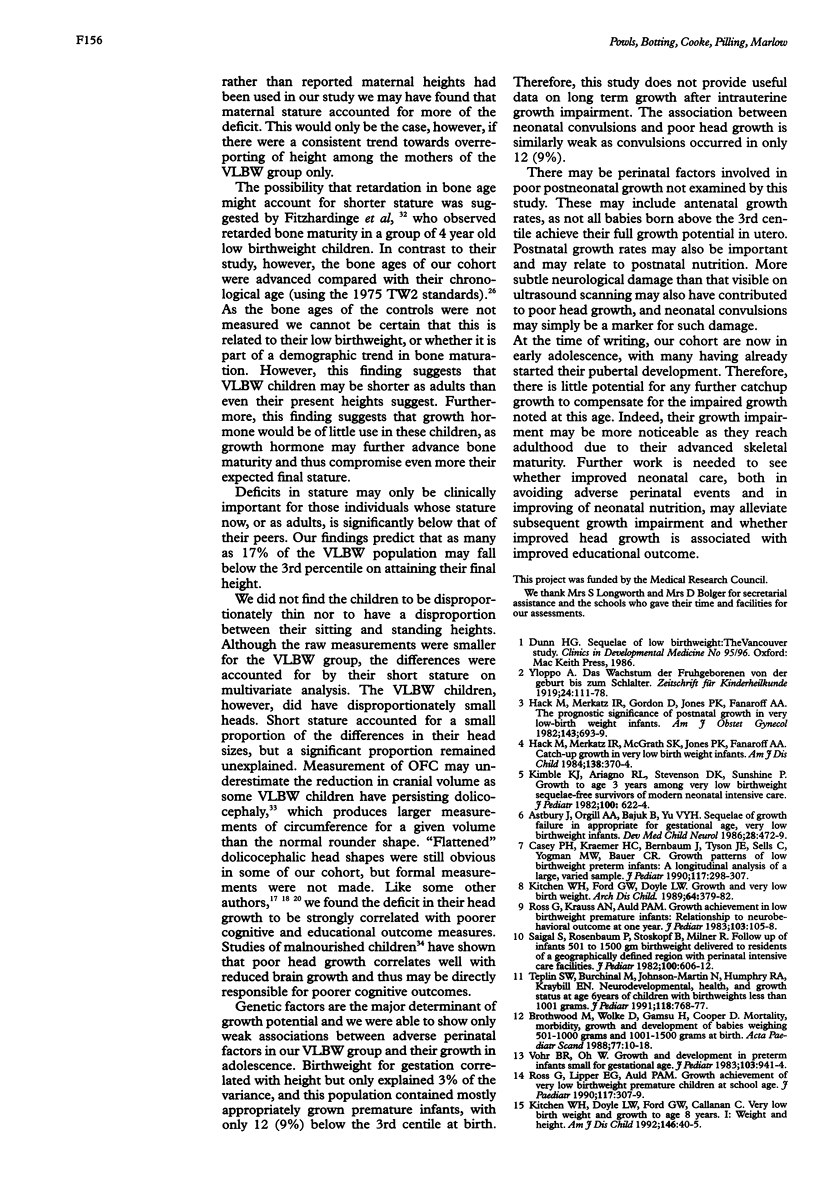
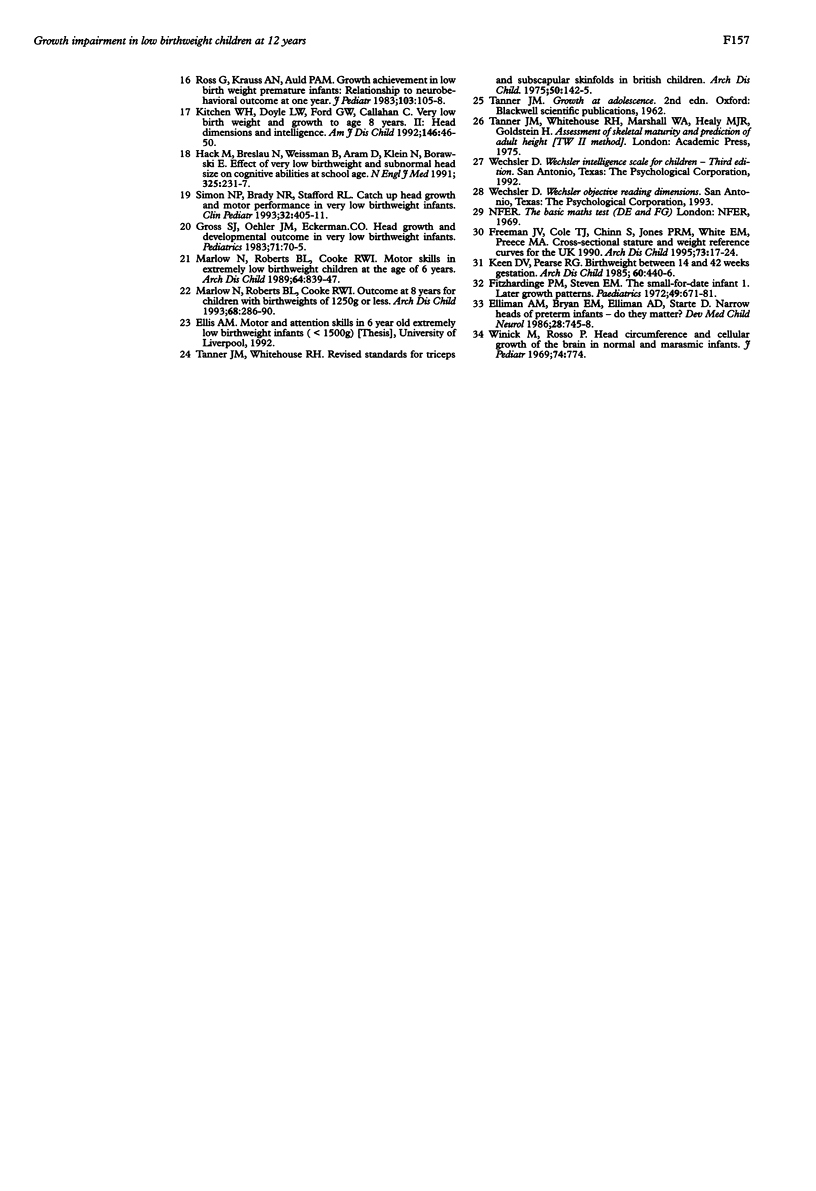
Selected References
These references are in PubMed. This may not be the complete list of references from this article.
- Astbury J., Orgill A. A., Bajuk B., Yu V. Y. Sequelae of growth failure in appropriate for gestational age, very low-birthweight infants. Dev Med Child Neurol. 1986 Aug;28(4):472–479. doi: 10.1111/j.1469-8749.1986.tb14285.x. [DOI] [PubMed] [Google Scholar]
- Brothwood M., Wolke D., Gamsu H., Cooper D. Mortality, morbidity, growth and development of babies weighing 501-1,000 grams and 1,001-1,500 grams at birth. Acta Paediatr Scand. 1988 Jan;77(1):10–18. doi: 10.1111/j.1651-2227.1988.tb10590.x. [DOI] [PubMed] [Google Scholar]
- Casey P. H., Kraemer H. C., Bernbaum J., Tyson J. E., Sells J. C., Yogman M. W., Bauer C. R. Growth patterns of low birth weight preterm infants: a longitudinal analysis of a large, varied sample. J Pediatr. 1990 Aug;117(2 Pt 1):298–307. doi: 10.1016/s0022-3476(05)80551-7. [DOI] [PubMed] [Google Scholar]
- Elliman A. M., Bryan E. M., Elliman A. D., Starte D. Narrow heads of preterm infants--do they matter? Dev Med Child Neurol. 1986 Dec;28(6):745–748. doi: 10.1111/j.1469-8749.1986.tb03927.x. [DOI] [PubMed] [Google Scholar]
- Fitzhardinge P. M., Steven E. M. The small-for-date infant. I. Later growth patterns. Pediatrics. 1972 May;49(5):671–681. [PubMed] [Google Scholar]
- Freeman J. V., Cole T. J., Chinn S., Jones P. R., White E. M., Preece M. A. Cross sectional stature and weight reference curves for the UK, 1990. Arch Dis Child. 1995 Jul;73(1):17–24. doi: 10.1136/adc.73.1.17. [DOI] [PMC free article] [PubMed] [Google Scholar]
- Hack M., Breslau N., Weissman B., Aram D., Klein N., Borawski E. Effect of very low birth weight and subnormal head size on cognitive abilities at school age. N Engl J Med. 1991 Jul 25;325(4):231–237. doi: 10.1056/NEJM199107253250403. [DOI] [PubMed] [Google Scholar]
- Hack M., Merkatz I. R., Gordon D., Jones P. K., Fanaroff A. A. The prognostic significance of postnatal growth in very low--birth weight infants. Am J Obstet Gynecol. 1982 Jul 15;143(6):693–699. doi: 10.1016/0002-9378(82)90117-x. [DOI] [PubMed] [Google Scholar]
- Hack M., Merkatz I. R., McGrath S. K., Jones P. K., Fanaroff A. A. Catch-up growth in very-low-birth-weight infants. Clinical correlates. Am J Dis Child. 1984 Apr;138(4):370–375. doi: 10.1001/archpedi.1984.02140420036013. [DOI] [PubMed] [Google Scholar]
- Keen D. V., Pearse R. G. Birthweight between 14 and 42 weeks' gestation. Arch Dis Child. 1985 May;60(5):440–446. doi: 10.1136/adc.60.5.440. [DOI] [PMC free article] [PubMed] [Google Scholar]
- Kimble K. J., Ariagno R. L., Stevenson D. K., Sunshine P. Growth to age 3 years among very low-birth-weight sequelae-free survivors of modern neonatal intensive care. J Pediatr. 1982 Apr;100(4):622–624. doi: 10.1016/s0022-3476(82)80770-1. [DOI] [PubMed] [Google Scholar]
- Kitchen W. H., Doyle L. W., Ford G. W., Callanan C., Rickards A. L., Kelly E. Very low birth weight and growth to age 8 years. II: Head dimensions and intelligence. Am J Dis Child. 1992 Jan;146(1):46–50. doi: 10.1001/archpedi.1992.02160130048020. [DOI] [PubMed] [Google Scholar]
- Kitchen W. H., Doyle L. W., Ford G. W., Callanan C. Very low birth weight and growth to age 8 years. I: Weight and height. Am J Dis Child. 1992 Jan;146(1):40–45. doi: 10.1001/archpedi.1992.02160130042019. [DOI] [PubMed] [Google Scholar]
- Kitchen W. H., Ford G. W., Doyle L. W. Growth and very low birth weight. Arch Dis Child. 1989 Mar;64(3):379–382. doi: 10.1136/adc.64.3.379. [DOI] [PMC free article] [PubMed] [Google Scholar]
- Marlow N., Roberts B. L., Cooke R. W. Motor skills in extremely low birthweight children at the age of 6 years. Arch Dis Child. 1989 Jun;64(6):839–847. doi: 10.1136/adc.64.6.839. [DOI] [PMC free article] [PubMed] [Google Scholar]
- Marlow N., Roberts L., Cooke R. Outcome at 8 years for children with birth weights of 1250 g or less. Arch Dis Child. 1993 Mar;68(3 Spec No):286–290. doi: 10.1136/adc.68.3_spec_no.286. [DOI] [PMC free article] [PubMed] [Google Scholar]
- Ross G., Krauss A. N., Auld P. A. Growth achievement in low-birth-weight premature infants: relationship to neurobehavioral outcome at one year. J Pediatr. 1983 Jul;103(1):105–108. doi: 10.1016/s0022-3476(83)80791-4. [DOI] [PubMed] [Google Scholar]
- Ross G., Krauss A. N., Auld P. A. Growth achievement in low-birth-weight premature infants: relationship to neurobehavioral outcome at one year. J Pediatr. 1983 Jul;103(1):105–108. doi: 10.1016/s0022-3476(83)80791-4. [DOI] [PubMed] [Google Scholar]
- Ross G., Lipper E. G., Auld P. A. Growth achievement of very low birth weight premature children at school age. J Pediatr. 1990 Aug;117(2 Pt 1):307–309. doi: 10.1016/s0022-3476(05)80552-9. [DOI] [PubMed] [Google Scholar]
- Saigal S., Rosenbaum P., Stoskopf B., Milner R. Follow-up of infants 501 to 1,500 gm birth weight delivered to residents of a geographically defined region with perinatal intensive care facilities. J Pediatr. 1982 Apr;100(4):606–613. doi: 10.1016/s0022-3476(82)80767-1. [DOI] [PubMed] [Google Scholar]
- Simon N. P., Brady N. R., Stafford R. L. Catch-up head growth and motor performance in very-low-birthweight infants. Clin Pediatr (Phila) 1993 Jul;32(7):405–411. doi: 10.1177/000992289303200704. [DOI] [PubMed] [Google Scholar]
- Tanner J. M., Whitehouse R. H. Revised standards for triceps and subscapular skinfolds in British children. Arch Dis Child. 1975 Feb;50(2):142–145. doi: 10.1136/adc.50.2.142. [DOI] [PMC free article] [PubMed] [Google Scholar]
- Teplin S. W., Burchinal M., Johnson-Martin N., Humphry R. A., Kraybill E. N. Neurodevelopmental, health, and growth status at age 6 years of children with birth weights less than 1001 grams. J Pediatr. 1991 May;118(5):768–777. doi: 10.1016/s0022-3476(05)80045-9. [DOI] [PubMed] [Google Scholar]
- Vohr B. R., Oh W. Growth and development in preterm infants small for gestational age. J Pediatr. 1983 Dec;103(6):941–945. doi: 10.1016/s0022-3476(83)80726-4. [DOI] [PubMed] [Google Scholar]
- Winick M., Rosso P. Head circumference and cellular growth of the brain in normal and marasmic children. J Pediatr. 1969 May;74(5):774–778. doi: 10.1016/s0022-3476(69)80140-x. [DOI] [PubMed] [Google Scholar]


